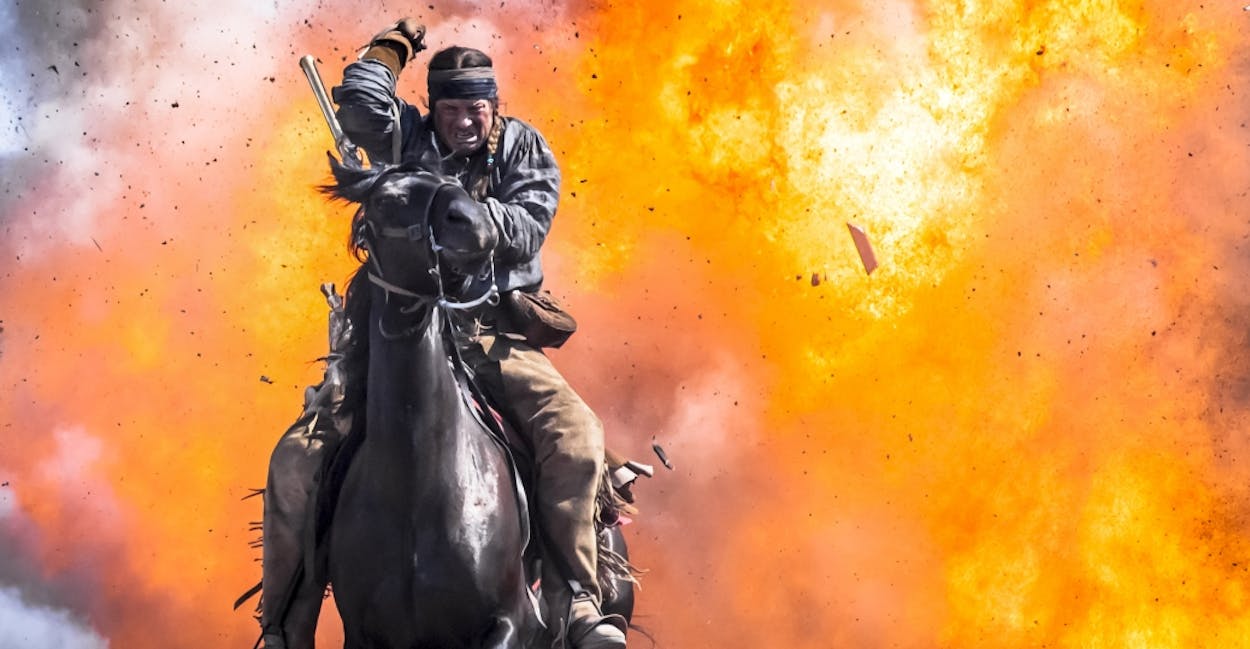Editor’s note: When we heard History would be airing a ten-hour miniseries about the Texas Revolution, of course we had to tune in. Stephen Harrigan, Texas Monthly’s film and television columnist, reviewed the first four hours of the show in this month’s issue of the magazine. Now, he and James Donovan, author of The Blood of Heroes: The 13-Day Struggle for the Alamo—and the Sacrifice That Forged a Nation, will watch each episode and discuss just how accurate—or, at the very least, entertaining—the series is. (Scroll down to read the rest of their coverage.)
Steve,
Let’s not beat around the bush. Here’s what I think worked—and what didn’t—in Episode 4:
The Not-So-Great Raid of 1836—Yes, there was an Indian raid on Victoria, but it occurred four years later than when Texas Rising suggests. Victoria and another town, Linville, were attacked by 300 or so Comanches and Kiowas under the leadership of Buffalo Hump, in what became known as The Great Raid of 1840. They killed at least thirty people, and burned and plundered at will. The inept Indian attack on Victoria in this episode, by contrast, resembles something out of the ‘60s TV comedy series F Troop. The small band of Comanches who ride slowly through town—and who hardly seem worthy of the wide-eyed terror the mere mention of their name evokes—are easily ambushed by the badly hidden townspeople lining Main Street.
The Bridge Over the River Sims—We can’t very well expect something as suspenseful or elaborate as the demolition sequence in David Lean’s 1957 masterpiece The Bridge Over the River Kwai—still the gold standard for bridge blowups—but the scenes portraying the battle at Vince’s Bridge (which most likely crossed Sims Bayou and not Vince’s Bayou, as is commonly believed) fall way short. Not only is this bridge absurdly large—it’s wide enough and strong enough for an eighteen-wheeler dragging a double-wide trailer home—but the Mexican soldiers sent down to walk along its pedestrian catwalk don’t even look under the bridge, where several Rangers crouch a few feet away. And when Billy Anderson, the Indian-reared character played by Brendan Fraser, is trapped in the middle of the blown bridge, the continuity is so sloppy that the chasm he has to leap miraculously shrinks from about ten feet to four. The entire sequence is unimaginatively staged, shot, and edited, and it’s not helped by an odd undercurrent of humor that’s presaged by weasely Ranger Ephraim Knowles (Jeremy Davies), who decides that the perfect time and place to take a bladder break is a dozen yards from the bridge, right when the Mexican army is approaching the other side.
The Battle of San Jacinto—In military terms, the word massacre is usually reserved for an engagement in which one side is unarmed. On April 21, 1836 both sides were well-armed, but the battle that day was pretty much a massacre even so. It was essentially over in eighteen minutes, though carnage on a grand scale followed for another hour, as blind bloodlust took over the hopped-up Texians. In the end, six hundred Mexican soldiers lay dead; Texian casualties included seven deaths and thirty or so wounded (four more would die later). Though the field of battle was different than it’s portrayed here—the Texians actually crossed a wide, open prairie of several hundred yards before engaging the surprised Mexican army, not the smaller, wooded battleground through which Houston leads his men—the overall scene is accurate enough, with plenty of true historical details. The Mexican army really was taking a siesta (though of course there’s absolutely no evidence of Santa Anna’s snooze being post-coital, as has long been rumored—way to go, Ms. West!), and, even harder to believe, no sentries had been set out. One Mexican general, Manuel Fernandez Castrillon, really did attempt to rally his troops, unsuccessfully, and was shot dead, and Colonel Juan Almonte, Santa Anna’s chief of staff, did surrender with hundreds of troops. Houston’s horse really was shot out from under him (two horses were, actually), and a Mexican musket ball did shatter his ankle—though the shot didn’t come from Santa Anna. Speaking of dead horses . . .
The Death of Deaf Smith’s Horse—The most moving scene in the entire series, and they didn’t even do it right. Yes, Ranger Smith’s love for his mount, and his grief when he has to put him down, is so palpable that the scene worked well enough, thanks to some fine acting from Jeffrey Dean Morgan. For the first time while watching the series, I got a lump in my throat. But if the screenwriters had bothered to craft an earlier scene or two establishing Smith’s bond with his horse, I probably would have cried like a Texas newcomer tasting his first chili pepper.
Which leads to the basic problem of this series: if the death of a horse is the most touching scene in this production, what does that say about it? Shouldn’t the trials and tribulations of some of the human characters move us just as strongly, if not more?
—Jim
Previous coverage of Texas Rising:
James Donovan watches the first four hours: “Let’s Not Count Out Texas Rising Just Yet”
Stephen Harrigan’s response: “The Very Blurry Line Between Fact and Fiction”
James Donovan on episode 3: “Are You Not Entertained?”
Stephen Harrigan on episode 3: “We Have Minutiae, But Where Is the Nuance?”
James Donovan on episode 4: “The Basic Problem with “Texas Rising”? A Lack of Human Connection”
Stephen Harrigan on episode 4: “The Latest Installment Is the Most Superior Yet”
James and Stephen discuss the final episode: “So About That ‘Texas Rising’ Finale . . .”






